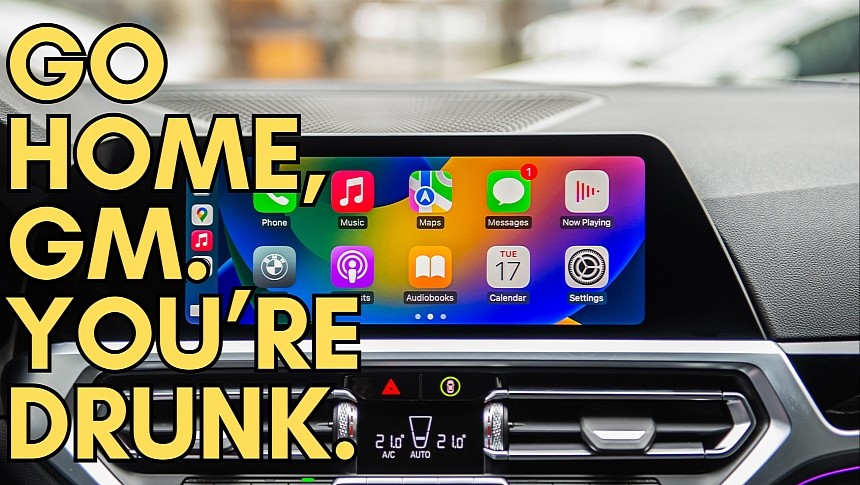General Motors was the first (and currently the only) carmaker to decide to drop Android Auto and CarPlay for an integrated operating system in its cars. While Tesla and Rivian don't offer CarPlay either, General Motors previously installed the system on its cars, so removing the phone mirroring systems was a major change of strategy.
GM's switch to Android Automotive and the decision to ban CarPlay and Android Auto were received with much criticism by existing customers and potential buyers.
While adopting Android Automotive isn't a problem, dropping CarPlay certainly is. General Motors has the technical capabilities to offer both in its vehicles, but the company believes that going all-in on Android Automotive is the right way.
Ever since it announced this controversial strategy, General Motors has been struggling to convince the world it's making the right call. The company's executives came up with all kinds of justifications, suggesting on several occasions that neither Android Auto nor CarPlay can offer the advanced functionality in Android Automotive.
GM eventually said it wants to provide buyers with an upgraded experience behind the wheel, and only AAOS allows it.
Now, Tim Babbitt, GM's head of product for infotainment, offered another reason for abandoning Android Auto and CarPlay. GM is aiming for improved safety, he says in an interview, suggesting that Android Auto and CarPlay can become dangerous for drivers.
Babbitt says drivers are likely to interact with the phone when running Android Auto and CarPlay, whereas AAOS offers the complete feature package, making a mobile device redundant.
However, the GM executive forgets one important aspect. Android Auto and CarPlay were designed specifically to make a mobile device redundant while driving, as all the information on the smartphone is transferred to the infotainment system. It's the reason the entire experience is powered by the smartphone, so once you connect it to the car, you get your calls, messages, apps, and emails on the larger screen. You can use them with voice commands so you can focus on the road without touching the display.
Babbitt is somewhat right in one aspect through. He says Android Auto and CarPlay are buggy and often encounter bad connections and other issues, so drivers would be tempted to pick up their phones to fix these bugs. It's partially true, as a random disconnect in the middle of the drive, which many drivers encountered when running Android Auto and CarPlay, could make the person behind the wheel struggle with cables and the mobile device while in motion.
Oddly enough, Babbitt admits that GM hasn't yet tested if and how Android Automotive makes the experience behind the wheel safer. It's just an assumption for the moment because, you know, everybody blasted the carmaker for its awful decision, and it can't find a solid reason to defend its strategy.
While adopting Android Automotive isn't a problem, dropping CarPlay certainly is. General Motors has the technical capabilities to offer both in its vehicles, but the company believes that going all-in on Android Automotive is the right way.
Ever since it announced this controversial strategy, General Motors has been struggling to convince the world it's making the right call. The company's executives came up with all kinds of justifications, suggesting on several occasions that neither Android Auto nor CarPlay can offer the advanced functionality in Android Automotive.
GM eventually said it wants to provide buyers with an upgraded experience behind the wheel, and only AAOS allows it.
Now, Tim Babbitt, GM's head of product for infotainment, offered another reason for abandoning Android Auto and CarPlay. GM is aiming for improved safety, he says in an interview, suggesting that Android Auto and CarPlay can become dangerous for drivers.
Babbitt says drivers are likely to interact with the phone when running Android Auto and CarPlay, whereas AAOS offers the complete feature package, making a mobile device redundant.
However, the GM executive forgets one important aspect. Android Auto and CarPlay were designed specifically to make a mobile device redundant while driving, as all the information on the smartphone is transferred to the infotainment system. It's the reason the entire experience is powered by the smartphone, so once you connect it to the car, you get your calls, messages, apps, and emails on the larger screen. You can use them with voice commands so you can focus on the road without touching the display.
Babbitt is somewhat right in one aspect through. He says Android Auto and CarPlay are buggy and often encounter bad connections and other issues, so drivers would be tempted to pick up their phones to fix these bugs. It's partially true, as a random disconnect in the middle of the drive, which many drivers encountered when running Android Auto and CarPlay, could make the person behind the wheel struggle with cables and the mobile device while in motion.
Oddly enough, Babbitt admits that GM hasn't yet tested if and how Android Automotive makes the experience behind the wheel safer. It's just an assumption for the moment because, you know, everybody blasted the carmaker for its awful decision, and it can't find a solid reason to defend its strategy.









